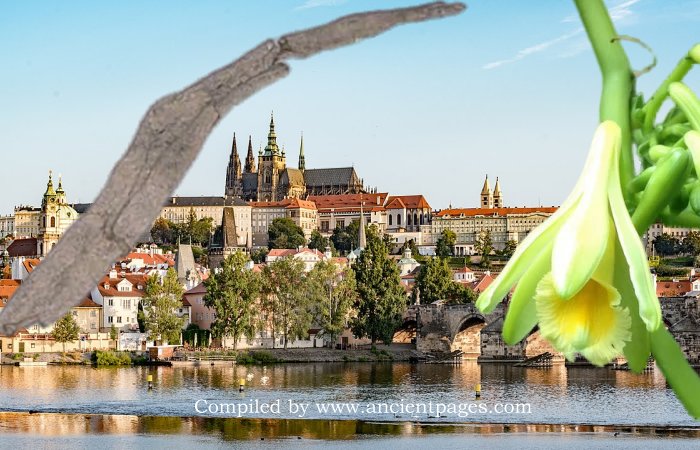Jan Bartek – AncientPages.com – When archaeologists explored the Great Vladislav Hall in Prague Castle, Czech Republic, they made intriguing discoveries including lost jewelry and 17th-century playing cards hidden between the floorboards. Among these finds was a mysterious botanical material that initially puzzled researchers. Through chemical analysis, it was identified as a vanilla pod from the early modern period, marking it as the oldest evidence of vanilla use in Europe.
Credit: Tilman2007 – CC BY-SA 4.0, J. Irmišová et al. and Malcolm Manners – CC BY 2.0. Image compilation by AncientPages.com
Prague Castle stands as the largest coherent castle complex in the world and holds the prestigious status of a UNESCO World Heritage site. Historically, it served as the center of the Bohemian kingdom and was home to early medieval Bohemian dukes and kings. During the Early Modern period, it became a hub of economic activity. Since 1925, Prague Castle and the nearby historical town of Hradcany have been key sites for archaeological research.
In the 16th century, under Habsburg rule, which extended across Europe including Spain, Burgundy, and parts of the Netherlands, Prague played a significant role in Central European development. The importation of various species and raw materials highlights this influence. The Bohemian nobility began adopting cosmopolitan traits due to extensive Habsburg connections abroad—a fact reflected in luxury plant structures in archaeological assemblages from that era.
The Vladislav Hall at Prague Castle was built between 1490 and 1502 under King Ladislaus Jagiello’s direction. It hosted royal ceremonies such as coronation banquets for Bohemia’s kings and served as a marketplace for luxury goods, art, and book production. An engraving by Egidius Sadeler from 1607 provides evidence of these activities within this grand hall.
The vanilla pod was discovered near the side doors on the left at Prague Castle’s Vladislav Hall. Credit: J. Irmišová et al.
During Holy Roman Emperor Rudolf II’s reign, Vladislav Hall became a cultural and trade hub in Europe. In the Habsburg era, Vladislav Hall hosted feasts and knightly tournaments and served as a market hall for goods destined for the imperial court from across the globe. The discovery of this vanilla pod suggests that exotic plants and foods were reaching Europe during this time.
The vanilla found at Prague Castle originates from Mesoamerica or the Caribbean; its earliest recorded mention dates back to 1450, when Aztecs paired it with cocoa beans—a practice later adopted by Europe’s elite nobility. While cocoa wasn’t found alongside this pod—unsurprising given its inability to endure over centuries—the presence of vanilla raises questions about its use at Emperor Rudolf II’s court.
See also: More Archaeology News
Researchers identified this ancient pod through plant macro remain analysis within Vladislav Hall’s floor vault infill. Radiocarbon dating places it between 1513–1666 C.E, consistent with archaeological timelines based on stratigraphy and building history during Prague Castle’s tenure as an imperial Habsburg residence (1583–1611). Archaeobotanist Jitka Irmišová notes that dryness preserved this specimen well.
Although it’s unclear how exactly vanilla was utilized within Prague Castle’s walls under Emperor Rudolf II—who famously collected exotic items while pursuing alchemical endeavors—the discovery underscores his era’s fascination with rare objects amidst broader European cultural exchanges involving spices like pepper where one might not expect them used together traditionally!
Written by Jan Bartek – AncientPages.com Staff Writer



